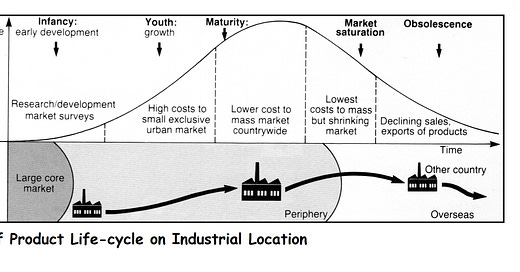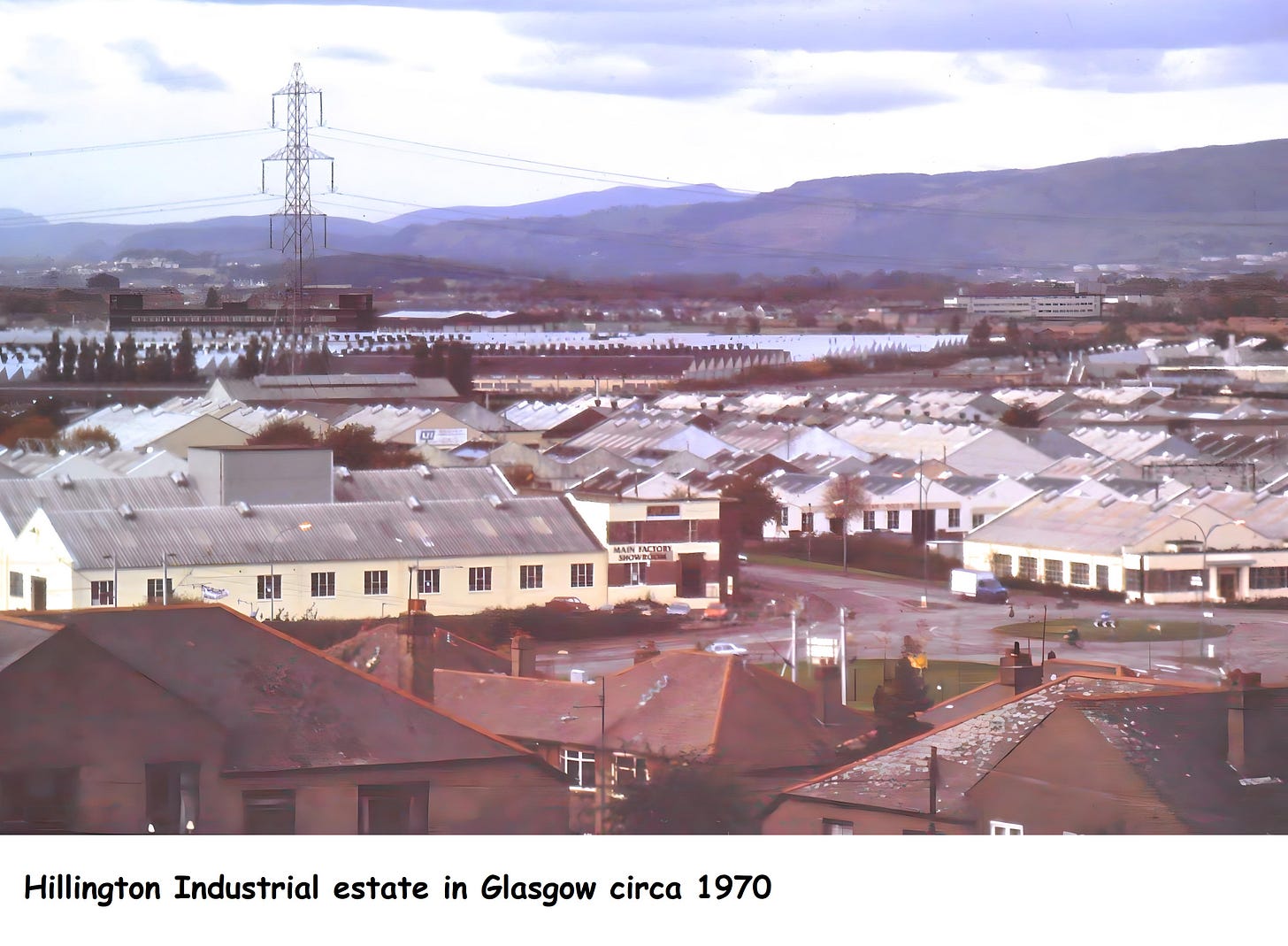Industrial Geography 4
Chapter Two - Part Three - Other factors influencing Industrial location
Product life cycle
The product life cycle (PLC) is a concept that describes the stages a product goes through from its introduction to its eventual decline in the market. It represents the evolution of sales and profits over time and helps businesses understand the dynamics of a product’s market performance. The PLC typically consists of four stages: introduction, growth, maturity, and decline.
Introduction Stage: The introduction stage is the initial phase of a product’s life cycle, where it is launched into the market. During this stage, sales are low, and companies often incur high costs due to product development, marketing, and distribution efforts. The focus is on creating awareness and generating demand among early adopters. Prices may be higher initially to recover the development and launch expenses.
Examples of products in the introduction stage include newly developed technologies, innovative gadgets, and niche products with limited customer awareness. For example, the introduction of electric vehicles (EVs) in recent years. As EV technology evolved, companies like Tesla introduced their electric cars to the market. Initially, sales were limited, and the costs of research and development, battery production, and charging infrastructure were substantial. However, companies invested in marketing and educating consumers about the benefits of EVs, laying the foundation for future growth.
Growth Stage: The growth stage is characterised by rapid market acceptance and increasing sales. During this phase, consumer awareness and demand for the product grow, leading to a surge in sales volume and market share. Competition intensifies as more players enter the market, and prices may start to stabilise or slightly decrease. Companies focus on expanding their distribution channels, improving product features, and capturing a larger market share. The growth stage often experiences the highest profitability.
A prime example of a product in the growth stage is smartphones. With the introduction of smartphones, companies like Apple and Samsung experienced exponential growth as consumers embraced the new technology. As the market expanded, competition increased, prices became more competitive, and companies invested in product enhancements and expanded distribution networks to cater to the growing demand.
Maturity Stage: The maturity stage is characterised by a stable market and saturation of demand. Sales growth slows down as most potential customers have already adopted the product. Competition remains intense, and price wars may occur as companies strive to maintain or gain market share. During this stage, companies focus on differentiating their product through branding, customer service, and product variations to attract and retain customers. They may also explore new market segments or international markets to sustain growth. Profit margins tend to stabilise or decline.
An example of a product in the maturity stage is the personal computer (PC). PCs became widely adopted in households and businesses, reaching a point of market saturation. As the technology matured, sales growth slowed, and competition became fierce. To stay competitive, PC manufacturers focused on brand differentiation, product features like portability and touchscreen capability, and targeting specific market segments such as gaming or professional use.
Decline Stage: The decline stage occurs when a products sales and profitability decline significantly. This decline can be due to various factors, such as changing consumer preferences, technological advancements rendering the product obsolete, or the emergence of substitutes. Companies may face declining sales, reduced market share, and decreasing profit margins. Strategies during this stage include cost-cutting, product diversification, or phasing out the product altogether.
An example of a product in the decline stage is traditional film cameras. With the rise of digital cameras and smartphones with advanced camera capabilities, the demand for film cameras declined sharply. Manufacturers had to make the transition to digital technology or exit the market altogether.
Understanding the product life cycle is crucial for businesses as it helps them make strategic decisions related to product development, marketing, pricing, and resource allocation at each stage. By recognising the characteristics of each stage, companies can adapt their strategies to maximise profitability
UK government intervention in industry since 1945
Since 1945, the UK government has played an active role in intervening and shaping various industries through policies and interventions. Here are some notable examples of government intervention in different sectors:
Nationalisation of Industries: In the immediate post-war period, the UK government embarked on a significant wave of nationalisation, bringing key industries and utilities under public ownership. Industries such as coal mining, steel, railways, and utilities like electricity, gas, and telecommunications were nationalised. The objective was to ensure public control, improve efficiency, and address social and economic inequalities.
Creation of National Health Service (NHS): In 1948, the UK government introduced the National Health Service (NHS), a publicly funded healthcare system providing universal healthcare to all citizens. This intervention aimed to address inequalities in access to healthcare, provide free medical services, and improve the overall health and well-being of the population.
Industrial Policy: The UK government has implemented various industrial policies over the years to support and develop key sectors of the economy. For instance, in the 1960s and 1970s, industrial policies focused on promoting technological innovation and supporting industries like aerospace, automotive, and electronics. These policies aimed to enhance competitiveness, encourage research and development, and create employment opportunities.
Privatisation: Starting in the 1980s, the UK government pursued a policy of privatisation, reversing the trend of nationalisation. Under the leadership of Prime Minister Margaret Thatcher, state-owned enterprises, including British Telecom, British Airways, and British Gas, were privatised. The objective was to increase efficiency, introduce competition, and attract private investment in previously state-controlled industries.
Financial Sector Regulation: Following the financial crises of the 2000s, the UK government introduced various measures to regulate and stabilise the financial sector. The Financial Services Act 2012 established the Financial Conduct Authority (FCA) and the Prudential Regulation Authority (PRA) to oversee and regulate financial institutions. These interventions aimed to strengthen financial stability, enhance consumer protection, and prevent future crises.
Renewable Energy and Climate Change Policies: In recent years, the UK government has implemented policies to promote renewable energy and address climate change. Initiatives such as the Renewable Energy Roadmap, Feed-in Tariffs, and the Carbon Price Floor have encouraged investments in renewable energy sources like wind, solar, and biomass. These interventions aim to reduce greenhouse gas emissions, diversify the energy mix, and transition to a low-carbon economy.
Industrial Strategy and Sectoral Support: In 2017, the UK government launched an
Industrial Strategy aimed at supporting key sectors and promoting economic growth. The strategy focuses on sectors like advanced manufacturing, artificial intelligence, clean energy, and life sciences. It includes measures such as research and development funding, infrastructure investments, and support for skills development to foster innovation, productivity, and competitiveness.
Freeports as part of industrial policy : Freeports are designated areas where businesses can benefit from tax incentives, simplified customs procedures, and regulatory flexibility, the aim is to boost economic growth, trade, and investment.
Since 2021, the government has announced 12 Freeports, which are expected to create over 200,000 jobs. These Freeports aim to transform industrial regions by attracting investment in high-innovation, low-carbon technologies. For example, the Humber Freeport has secured investment for the UK’s first rare earth processing facility, while the Teesside Freeport is attracting major offshore wind manufacturing projects.
To accelerate the success of Freeports, the government has introduced a £150 million Investment Opportunities Fund and extended special tax reliefs until 2031. These measures are designed to provide long-term support for businesses and ensure sustained economic benefits for local communities.
The policy is also part of the UK’s broader levelling-up agenda, aiming to regenerate port towns and cities by improving infrastructure and creating new opportunities for businesses and workers. The government is working with the UK Infrastructure Bank to finance upgrades to Freeport infrastructure, ensuring they remain competitive and attractive to investors.
It is important to note that the extent and nature of government intervention have varied over time and across different governments. These interventions reflect the evolving economic and political priorities of the UK and its efforts to shape industries, promote economic growth, and address societal challenges.
Impact on industrial location by the UK leaving the EU
The UKs departure from the European Union (EU), commonly known as Brexit, has had an impact on industrial location in the country. Here are some key factors influencing industrial location post-Brexit:
Access to the EU Single Market: Prior to Brexit, the UK had unrestricted access to the EU Single Market, which facilitated the free movement of goods, services, capital, and labour. This access allowed businesses to establish manufacturing plants and supply chains that relied on seamless trade with EU member states. With Brexit, the UKs access to the Single Market changed, resulting in additional trade barriers, such as customs checks, regulatory misalignment, and potential tariffs. This has led some companies to reconsider their industrial location decisions.
Supply Chain Disruptions: The reconfiguration of trade relationships due to Brexit has caused disruptions to supply chains. Industries that heavily relied on just-in-time delivery and integrated supply chains across the EU have faced challenges in terms of increased administrative burden, delays at borders, and potential disruption to the flow of goods. As a result, some companies have considered relocating parts of their manufacturing or distribution operations to maintain smoother supply chains within the EU.
Regulatory Environment: As an EU member, the UK operated under EU regulations and standards, which provided a harmonised framework for industries across the bloc. Following Brexit, the UK has the opportunity to establish its own regulatory regime. This can potentially create both opportunities and challenges for industrial location decisions. On one hand, the UK could tailor regulations to suit specific industries and attract investment. On the other hand, regulatory divergence from the EU may introduce complexities for businesses operating across both markets.
Labour Market and Skills: Freedom of movement allowed EU citizens to work and live in the UK without visa restrictions. The end of free movement following Brexit has impacted the availability of EU workers in the UK labour market. Industries reliant on EU workers, such as agriculture, hospitality, and healthcare, have experienced labour shortages. This could influence the location decisions of businesses that heavily relied on EU workers or preferred access to a larger labour pool.
Government Policies and Incentives: The UK government has sought to attractinvestment and encourage industrial development through policies and incentives. Post-Brexit, the government has the flexibility to shape industrial policies that align with its strategic objectives. This may involve targeted incentives, tax breaks, or investment in infrastructure to attract or retain industries. Government policies can impact the attractiveness of specific locations for industrial activities.
It is important to note that the impact of Brexit on industrial location is still unfolding, and the long-term consequences are not fully clear. Industrial location decisions are influenced by a wide range of factors beyond Brexit, including market demand, cost considerations, access to skilled labour, infrastructure, and proximity to suppliers and customers. While Brexit has introduced new dynamics and considerations, businesses evaluate multiple factors when deciding where to locate their industrial operations.
How industrial linkages affect industrial location
Industrial linkages refer to the interconnections and relationships between different industries within an economy. These linkages play a significant role in influencing industrial location decisions.
Supply Chain Integration: Industrial linkages are crucial for supply chain integration. Companies often prefer to locate their manufacturing facilities or distribution centres in close proximity to their suppliers and customers. By being geographically close to suppliers, businesses can reduce transportation costs, minimise lead times, and ensure a steady and reliable supply of inputs. Similarly, being near customers allows for quick and efficient delivery, better responsiveness to market demands, and the ability to provide timely customer support.
Clustering and Agglomeration Economies: Industrial linkages contribute to the formation of industrial clusters and agglomerations. Clusters are geographic concentrations of interconnected companies, suppliers, and related institutions within a specific industry or sector. Clustering provides several benefits, including knowledge sharing, access to specialised labour pools, technological spill-overs, and economies of scale. The presence of a strong cluster can attract new businesses, foster innovation, and enhance competitiveness. As a result, companies often choose to locate in or near established clusters to leverage these agglomeration economies.
Collaborative Networks and Innovation: Industrial linkages facilitate collaboration and knowledge sharing among companies. Proximity to research institutions, universities, and other industries can lead to the formation of collaborative networks and foster innovation. By locating in areas with a concentration of related industries and institutions, companies can access specialised expertise, engage in joint research and development (R&D) projects, and benefit from knowledge spill-overs. These collaborative networks can enhance productivity, drive innovation, and improve the competitiveness of businesses.
Infrastructure and Services: Industrial linkages influence the availability and quality of infrastructure and services in a specific location. Areas with a strong industrial base often have well-developed transportation networks, utilities, and supporting services tailored to the needs of industries. This includes infrastructure like roads, ports, airports, and reliable access to utilities such as electricity, water, and telecommunications. The presence of specialised service providers, such as logistics companies, technical support, and training institutions, can also be crucial for businesses. Companies tend to favour locations with well-established infrastructure and a supportive ecosystem that can facilitate their operations and reduce costs.
Labour Pool and Skills Availability: Industrial linkages impact the availability of a skilled labour pool in a particular location. Clusters and agglomerations tend to attract a concentration of skilled workers with industry-specific knowledge and expertise. This can be beneficial for businesses as it provides access to a talent pool that is trained and experienced in the specific requirements of the industry. The presence of related industries in the area can also support the development of specialised training programs and vocational institutions, further enhancing the availability of skilled labour.
In summary, industrial linkages affect industrial location by influencing supply chain integration, clustering and agglomeration economies, collaborative networks, access to infrastructure and services, and the availability of a skilled labour pool. Businesses consider these factors when making location decisions to optimise their operations, reduce costs, foster innovation, and gain a competitive advantage in the market.
Industrial estates or parks impacting on industrial location :
The innovation of industrial estates or parks has had a significant impact on industrial location decisions. Industrial estates or parks are designated areas specifically designed and developed to accommodate industrial activities. Here’s how their innovation has influenced industrial location:
Infrastructure and Facilities: Industrial estates offer well-planned infrastructure and facilities tailored to the needs of industries. They provide ready-to-use industrial plots or buildings with access to reliable utilities such as electricity, water, and telecommunications. The availability of modern infrastructure and facilities reduces the upfront costs and time required for businesses to establish their operations. This convenience and efficiency attract companies looking for a hassle-free setup, encouraging them to choose industrial estates as their preferred location.
Clustering and Synergies: Industrial estates foster clustering and the concentration of related industries within a designated area. By bringing together companies from similar or complementary sectors, industrial estates create opportunities for collaboration, knowledge sharing, and economies of scale. This clustering facilitates synergies and the exchange of ideas, technology, and expertise among businesses. The presence of a supportive ecosystem in industrial estates encourages innovation, enhances competitiveness, and increases the overall productivity of the industries located within them.
Regulatory Environment and Supportive Policies: Industrial estates often benefit from supportive government policies and a favourable regulatory environment. Governments may provide incentives, tax breaks, or streamlined administrative procedures for businesses locating within industrial estates. These incentives can attract companies, especially small and medium-sized enterprises (SMEs), by reducing their operating costs and bureaucratic burden. The supportive policies and regulatory framework in industrial estates create an attractive business environment and encourage industrial location in these designated areas.
Networking and Collaboration Opportunities: Industrial estates provide networking and collaboration opportunities through business associations, trade fairs, and industry- specific events. These platforms facilitate interactions among companies, suppliers, and service providers within the estate, fostering business relationships and potential partnerships. Networking and collaboration opportunities enhance the competitiveness of businesses located in industrial estates by promoting knowledge exchange, market access, and joint ventures.
Infrastructure and Resource Sharing: Industrial estates often promote infrastructure and resource sharing among companies. Shared facilities such as warehouses, logistics services, research and development centres, and training institutions can be provided within the estate. These shared resources reduce costs for individual businesses and enhance operational efficiency. For instance, companies can benefit from shared logistics infrastructure, reducing transportation costs and optimising supply chain operations. Shared resources also encourage cooperation and resource optimisation among businesses.
Environmental Considerations: Industrial estates incorporate sustainable and eco-friendly practices. They are designed to minimise environmental impacts and promote green initiatives. This includes energy-efficient buildings, waste management systems, water conservation measures, and green spaces. The emphasis on environmental sustainability attracts businesses that prioritise sustainability and wish to operate in a responsible manner. The availability of environmentally friendly infrastructure and facilities in industrial estates can influence the location decisions of companies committed to sustainability.
Overall, the innovation of industrial estates or parks has positively impacted industrial location by providing well-planned infrastructure, fostering clustering and synergies, offering a supportive regulatory environment, creating networking opportunities, enabling resource sharing, and promoting sustainability. These factors make industrial estates an attractive option for businesses looking for efficient operations, collaboration opportunities, and a conducive business environment.
Industrial changes of the late 20th century which have impacted on industrial
location
The late 20th century witnessed several key industrial changes that had a profound impact on industrial location and the composition of industries. Here are some of the significant changes:
Globalisation and Trade Liberalisation: The late 20th century saw a significant increase in globalisation and trade liberalisation. Trade barriers were reduced through agreements like the General Agreement on Tariffs and Trade (GATT) and the establishment of the World Trade Organisation (WTO). This led to the growth of global supply chains and increased international trade. As a result, industries began to locate their operations in countries with comparative advantages, such as lower labour costs or access to specific resources, leading to the emergence of new industrial hubs and the reshaping of global industrial geography.
Outsourcing and Offshoring: The trend of outsourcing and offshoring gained momentum in the late 20th century. Companies started to relocate certain stages of production or services to countries with lower costs or specialised capabilities. This led to the establishment of manufacturing plants or service centres in countries with competitive advantages, such as low wages or expertise in a particular sector. The relocation of production or services impacted industrial location as companies sought to optimise costs and take advantage of global opportunities.
Technological Advancements and Automation: The late 20th century witnessed significant technological advancements and the widespread adoption of automation in industries. Automation and advancements in information technology, robotics, and communication systems transformed industrial processes, making them more efficient and less labour-intensive. This shift in technology allowed companies to reconsider their industrial location decisions. Industries increasingly sought locations with access to skilled labour, research and development centres, and advanced technological infrastructure to support automation and innovation.
Decline of Traditional Manufacturing Industries: Many traditional manufacturing industries experienced significant changes in the late 20th century. Industries such as textiles, steel,and shipbuilding faced challenges from globalisation, increased competition, and changes in consumer preferences. As a result, these industries witnessed a decline in production and employment. Industrial locations that were once dominated by these sectors had to adapt and diversify their industrial makeup to remain economically viable.
Rise of Service Industries: The late 20th century witnessed the rise of service industries as significant contributors to economic growth. Industries such as finance, information technology, telecommunications, and business services experienced rapid expansion. The growth of service industries influenced industrial location decisions as companies sought locations with access to a skilled workforce, proximity to clients or markets, and supportive infrastructure.
Knowledge-based and High-Tech Industries: The late 20th century saw the emergence and growth of knowledge-based and high-tech industries. Sectors such as biotechnology, pharmaceuticals, aerospace, electronics, and software development became increasingly important. These industries relied on specialized knowledge, research and development capabilities, and access to skilled labour. Industrial locations that could support the unique requirements of these industries, including proximity to research institutions and availability of highly skilled workers, experienced growth and transformation.
Shifts in Consumer Preferences and Lifestyle: Changes in consumer preferences and lifestyle also influenced industrial location and the composition of industries. The rise of e-commerce, changing consumer demographics, and increased demand for personalised products and services led to the growth of industries such as online retail, digital entertainment, and customised manufacturing. Companies catering to these changing demands sought locations that allowed them to reach a large customer base, access innovative technologies, and respond quickly to changing market trends.
These industrial changes of the late 20th century impacted industrial location by shifting industries geographically, driving the rise of new industrial sectors, and influencing the transformation of traditional industries. Industrial locations that were able to adapt to these changes and offer the necessary infrastructure, skilled labour, and supportive ecosystem thrived, while others had to undergo significant adjustments to remain competitive in the evolving global industrial landscape.
Questions - Product Life Cycle (PLC)
1. Define the term 'Product Life Cycle' and identify its four main stages.
(2 marks)
2. Using examples, explain the characteristics of the introduction stage of the product life cycle.
(4 marks)
3. With reference to smartphones, discuss the strategies businesses might use during the growth stage of the product life cycle.
(6 marks)
4. Explain how competition and pricing change as a product enters the maturity stage. Use an example in your answer.
(4 marks)
5. Assess the impact of technological advancement on products in the decline stage. Use traditional film cameras as an example.
(6 marks)
6. Evaluate the usefulness of the Product Life Cycle model for businesses planning long-term marketing strategies.
(8 marks)
Questions UK Government Intervention in Industry Since 1945
1. Describe two examples of industries nationalised by the UK government after World War II.
(2 marks)
2. Explain why the UK government established the National Health Service (NHS) in 1948.
(4 marks)
3. Outline the main aims of the UK’s industrial strategy introduced in 2017.
(4 marks)
4. Compare the policies of nationalisation and privatisation in the UK. What were the goals of each, and how do they reflect changing government priorities?
(6 marks)
5. Discuss the role of Freeports in the UK’s current industrial strategy. Include examples in your response.
(6 marks)
6. To what extent has UK government intervention helped address regional inequalities in economic development since 1945?
(8–10 marks – evaluative essay question)
Short Answer Questions
What is one impact of Brexit on supply chains within the UK?
Define the term "industrial linkage."
Give one reason why industrial estates are attractive to new businesses.
State one way in which automation has affected industrial location.
Identify a late 20th-century change that contributed to the decline of traditional manufacturing industries in the UK.
Structured Questions
Explain how Brexit has affected the UK’s access to the EU Single Market and the implications for industrial location.
Describe two ways in which industrial linkages can influence where an industry is located.
Outline how the design of industrial estates helps reduce costs for businesses.
Discuss how the rise of high-tech and knowledge-based industries has influenced modern industrial location patterns in the UK.
Explain two government interventions after Brexit that aim to support industrial development.
Essay / Extended Response Questions
“Industrial estates promote efficiency and innovation.” To what extent do you agree with this statement? Use examples to support your answer.
Assess the impacts of Brexit on the industrial location of businesses in the UK. Consider both challenges and opportunities.
Evaluate how industrial linkages and agglomeration economies contribute to the success of industrial clusters in the UK.
“Technological advancement is the most significant factor in determining industrial location in the 21st century.” Discuss this view with reference to UK industry.
Examine how the shift from manufacturing to service and high-tech industries has reshaped industrial geography in the UK since the late 20th century.










